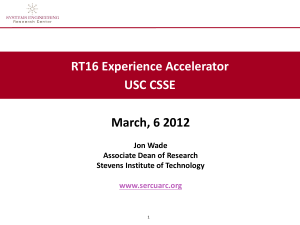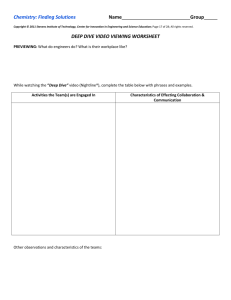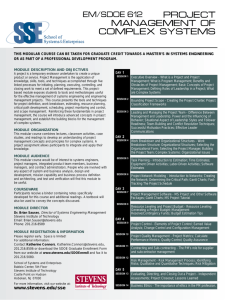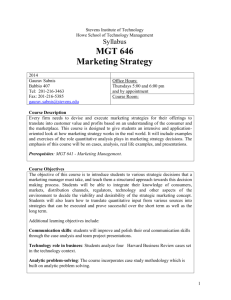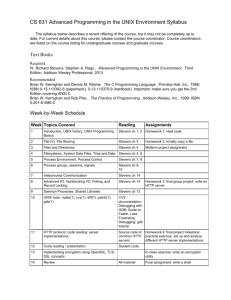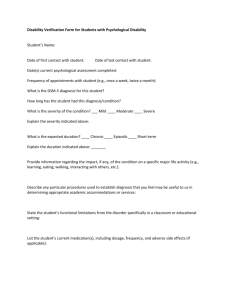ppt 2 - Systems Engineering Research Center
advertisement
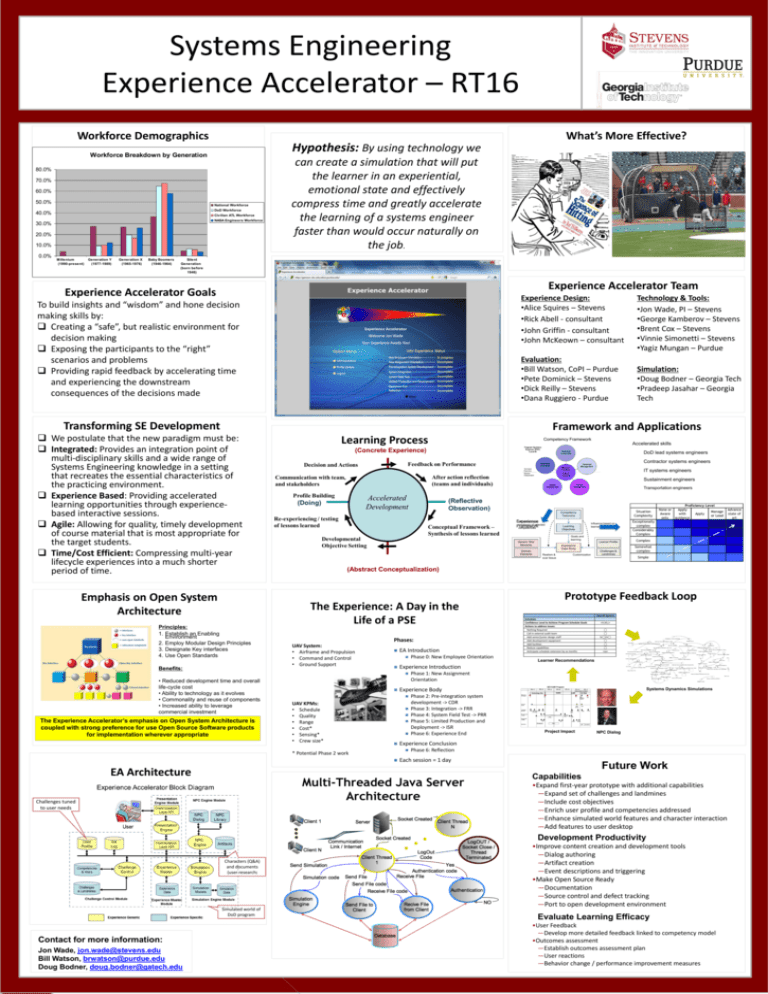
Systems Engineering Experience Accelerator – RT16 Workforce Demographics Hypothesis: By using technology we Workforce Breakdown by Generation 80.0% 70.0% 60.0% 50.0% National Workforce DoD Workforce 40.0% Civilian ATL Workforce NASA Engineers Workforce 30.0% 20.0% 10.0% 0.0% Millenium (1990-present) Generation Y (1977-1989) Generation X (1965-1976) Baby Boomers (1946-1964) What’s More Effective? can create a simulation that will put the learner in an experiential, emotional state and effectively compress time and greatly accelerate the learning of a systems engineer faster than would occur naturally on the job. Silent Generation (born before 1946) Experience Accelerator Team Experience Accelerator Goals Experience Design: •Alice Squires – Stevens •Rick Abell - consultant •John Griffin - consultant •John McKeown – consultant To build insights and “wisdom” and hone decision making skills by: Creating a “safe”, but realistic environment for decision making Exposing the participants to the “right” scenarios and problems Providing rapid feedback by accelerating time and experiencing the downstream consequences of the decisions made Evaluation: •Bill Watson, CoPI – Purdue •Pete Dominick – Stevens •Dick Reilly – Stevens •Dana Ruggiero - Purdue Transforming SE Development Principles: 1. Establish an Enabling Environment 2. Employ Modular Design Principles 3. Designate Key interfaces 4. Use Open Standards Benefits: Learning Process The Experience Accelerator’s emphasis on Open System Architecture is coupled with strong preference for use Open Source Software products for implementation wherever appropriate IT systems engineers Sustainment engineers Transportation engineers Competency Taxonomy Influence based Experience emphasis of selected Framework competencies Learning Objectives Influence based on learner skill level Goals and learning Generic 'Aha' Moments What’s More effective? The Experience: A Day in the Life of a PSE Phases: UAV System: • Airframe and Propulsion • Command and Control • Ground Support EA Introduction UAV KPMs: • Schedule • Quality • Range • Cost* • Sensing* • Crew size* Experience Case Study Realism & scar tissue Customization Challenges & Landmines Prototype Feedback Loop Overall System Schedule: Confidence Level to Achieve Program Schedule Goals Actions to address issues: Nothing Required Call in external audit team Add senior/junior design staff Add development equipment Add facilities Reduce capabilities Anticipate schedule extension by xx months <H,M,L> ⃝ ⃝ Sr⃝/Jr⃝ ⃝ ⃝ ⃝ <xx> Learner Recommendations Phase 1: New Assignment Orientation Experience Body Phase 0: New Employee Orientation Domain Elements Learner Profile Experience Introduction Phase 2: Pre-integration system development -> CDR Phase 3: Integration -> FRR Phase 4: System Field Test -> PRR Phase 5: Limited Production and Deployment -> ISR Phase 6: Experience End Systems Dynamics Simulations Project Impact NPC Dialog Experience Conclusion Phase 6: Reflection Each session = 1 day Multi-Threaded Java Server Architecture Challenges tuned to user needs Accelerated skills Contractor systems engineers * Potential Phase 2 work EA Architecture Competency Framework DoD lead systems engineers • Reduced development time and overall life-cycle cost • Ability to technology as it evolves • Commonality and reuse of components • Increased ability to leverage commercial investment Simulation: •Doug Bodner – Georgia Tech •Pradeep Jasahar – Georgia Tech Framework and Applications We postulate that the new paradigm must be: Integrated: Provides an integration point of multi-disciplinary skills and a wide range of Systems Engineering knowledge in a setting that recreates the essential characteristics of the practicing environment. Experience Based: Providing accelerated learning opportunities through experiencebased interactive sessions. Agile: Allowing for quality, timely development of course material that is most appropriate for the target students. Time/Cost Efficient: Compressing multi-year lifecycle experiences into a much shorter period of time. Emphasis on Open System Architecture Technology & Tools: •Jon Wade, PI – Stevens •George Kamberov – Stevens •Brent Cox – Stevens •Vinnie Simonetti – Stevens •Yagiz Mungan – Purdue Future Work Capabilities •Expand first-year prototype with additional capabilities ―Expand set of challenges and landmines ―Include cost objectives ―Enrich user profile and competencies addressed ―Enhance simulated world features and character interaction ―Add features to user desktop Development Productivity Characters (Q&A) and documents (user research) Simulated world of DoD program Contact for more information: Jon Wade, jon.wade@stevens.edu Bill Watson, brwatson@purdue.edu Doug Bodner, doug.bodner@gatech.edu •Improve content creation and development tools ―Dialog authoring ―Artifact creation ―Event descriptions and triggering •Make Open Source Ready ―Documentation ―Source control and defect tracking ―Port to open development environment Evaluate Learning Efficacy •User Feedback ―Develop more detailed feedback linked to competency model •Outcomes assessment ―Establish outcomes assessment plan ―User reactions ―Behavior change / performance improvement measures
